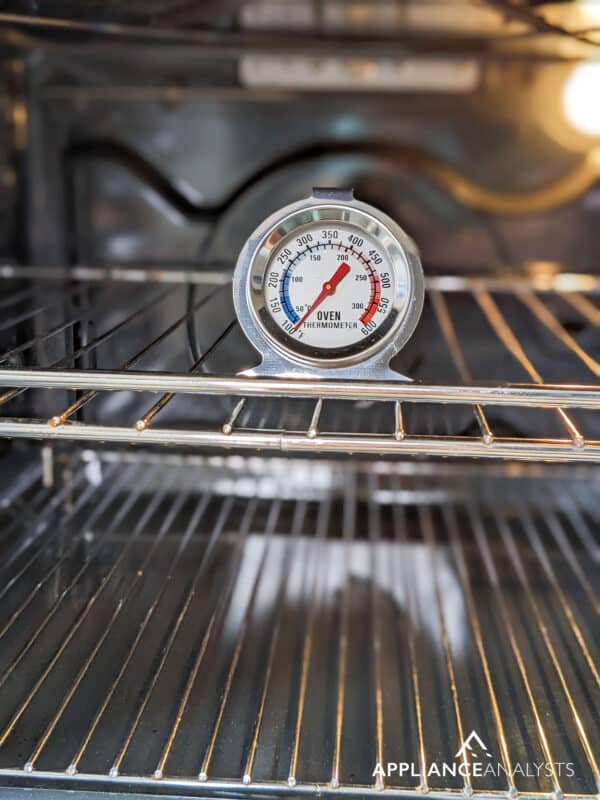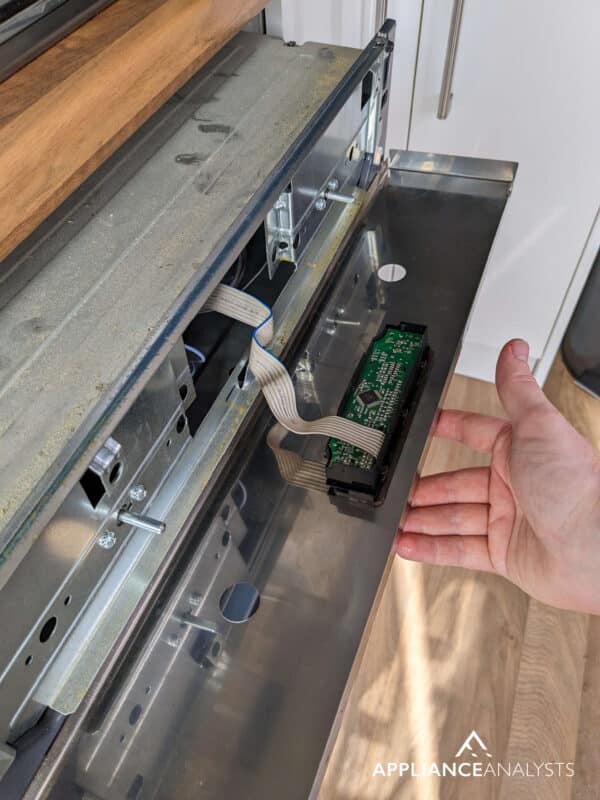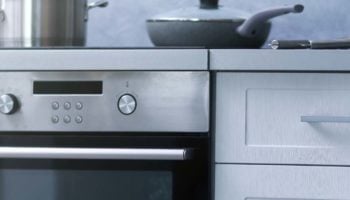We've independently reviewed this article to make sure it's as accurate as we can make it.
To find out more about our article creation and review process, check out our editorial guidelines.
Is heat escaping your oven?
That sucks! I know how frustrating heat loss can be, as it makes your oven less efficient and extends cooking times.
Don’t worry, though. I’m here to help.
If heat is escaping your oven, you’ll need to replace the door gasket, check the hinges, and examine the insulation. It’s also important to inspect the control board and temperature sensor, as their malfunctions can give the impression of heat loss.
Read on to learn how to fix the problem!
Why trust us? This article was written by Craig Anderson and James Blackford.
Craig has helped thousands of other homeowners repair their appliances since 2016.
James is one of our resident appliance experts with over 16 years of experience. He currently works as a Master Technician for SquareTrade, and runs his own appliance repair business.
How to Prevent Heat From Escaping Your Oven: 5 Steps
In this section, I’ll explain how to prevent heat from escaping your oven.
Keep in mind that it’s normal for some heat to escape, as ovens are not entirely airtight. A certain amount of heat loss through vents and small gaps is common.
However, if you find that your oven is experiencing excessive heat loss, it’s important to examine some of the internal components. To do so, please have the manufacturer’s manual handy.
Can’t find your manual? No problem! You can easily find any product’s manual online by clicking the link below.
Are you ready to fix the problem? Follow the next steps!
#1 Replace the Door Gasket
I find that when there’s heat escaping an oven, it’s typically due to a damaged or broken door gasket.
You see, the door gasket runs around the perimeter of the oven door, and it’s responsible for creating a tight seal to keep the hot air inside, ensuring efficient cooking. Over time, door gaskets can become damaged, resulting in heat leaks.

To determine if the door gasket is damaged, look for any visible signs of damage, such as cracks, tears, or loose sections. While you’re at it, please clean the gasket with warm water and vinegar (you can also use a kitchen degreaser). Sometimes, dirt and food debris on the gasket can prevent the door from closing and lead to heat leaks.
You can also test the door gasket by placing a piece of paper or a dollar bill half inside and half outside the oven and closing the door. Then, try pulling the paper out. If it slides out easily, you’ll need to get a replacement.
Here’s how to replace your oven’s door gasket:
- Please wait for the oven to cool down and unplug it from the power source to prevent electrical hazards. You can also turn it off at the circuit breaker.
- Open the door and carefully remove the old gasket. Start by pulling one end out and then remove all the pins or screws that hold the gasket in place.
- Clean the area where the door gasket was attached with an old toothbrush or soft sponge. Then, dry the area with a microfiber cloth or paper towel.
- Install the new oven door gasket. Start at a corner and press the clips into the holes. For gaskets with screws, simply align the new gasket and reinsert the screws.
- Ensure the gasket is evenly seated, and repeat the paper test mentioned above.
- Plug your oven back into the power outlet or turn it on at the circuit breaker.
Keep in mind that the process of removing and installing an oven door gasket will vary depending on the specific model you own, so please refer to the manufacturer’s manual.
#2 Check the Door Hinges
If heat still escapes your oven, I recommend checking the door hinges.
The hinges allow the door to open or close smoothly while ensuring proper alignment with the frame. Unfortunately, if the hinges are damaged or worn out, they can prevent the door from fully closing, leading to heat loss.
Therefore, it’s important to examine both hinges. If you notice any damage, misalignment, or if the door doesn’t move smoothly, it’s time to replace the hinges with new ones.
Here’s how to replace your oven’s door hinges:
- Unplug your oven from the power outlet or switch it off at the circuit breaker. Allow the oven to cool down completely.
- Partially open the oven door. Then, grab the door by the sides and carefully lift one side at a time.
- Carefully pull the door out of the oven and remove all the components that cover the hinges.
- Remove the screws securing the hinges in place. If there’s a weather strip, detach it as well. Then, apply glue to the weather strip and adhere it to the new hinge.
- Fit the new hinges onto the door and secure them with screws.
- Reattach all the components you previously removed.
- Align the door with the oven’s frame and slide the hinges back into their designated slots. The door should move smoothly.
Remember that the process of replacing the hinges will vary depending on the specific model you own. If you’re uncomfortable fixing your oven, it’s best to call an appliance repair expert.
#3 Check the Insulation
When fixing heat loss in an oven, my usual advice is to check the insulation.
All ovens have an interior layer of insulation that helps retain heat and maintain a consistent temperature. Unfortunately, the insulation can deteriorate over time, leading to heat loss.
To check your oven’s insulation, please unplug the appliance from the wall outlet or switch it off at the circuit breaker to prevent electrical hazards. Then, remove the door, back panel, and all the necessary covers.
Here’s a detailed video on how to access the insulation:
If the insulation is damaged, please replace it. Ensure the new insulation covers all areas evenly. Then, reattach any panels or covers you previously removed.
Once you’ve followed the instructions above, plug your oven back into the power outlet and select a cooking mode. Check if the issue was solved.
If heat is still escaping your oven, chances are there’s a problem with the temperature sensor or control board. Read on to learn more.
#4 Test the Temperature Sensor
If you’ve tried all the fixes above and the heat is still escaping your oven, the temperature sensor is likely malfunctioning.
Let me explain. The temperature sensor monitors and regulates your oven’s internal temperature. Unfortunately, when the sensor is faulty, it can send an incorrect signal to the control board to keep the heating elements on, causing the appliance to become hotter than the desired temperature.
A faulty temperature sensor can make you think that heat is escaping when, in fact, the oven is overheating.
The easiest way to rule out the temperature sensor as our possible culprit is by turning on the oven, setting a specific temperature, and placing an oven-safe thermometer on one of the racks. Once your oven has preheated, check the thermometer’s reading. The sensor is likely faulty if there’s a significant difference between the set temperature and the reading.

You can also test the temperature sensor with a multimeter. Here’s how to do it:
- Unplug your oven from the wall outlet and let it cool down.
- Access the temperature sensor, which is typically located on the oven’s back wall.
- Set your multimeter to the ohms settings and place one probe on one of the temperature sensor’s terminals and the other probe on the other terminal.
- You should get a reading between 1080 and 1100 ohms at room temperature (or as specified by the manufacturer).
- If you notice that the resistance doesn’t increase as the temperature rises or if it falls outside the recommended range, it’s an indication that you should replace the temperature sensor.
#5 Check the Control Board
If replacing the temperature sensor didn’t solve the issue, it’s time for us to check the control board.
The control board is one of the most important components in your oven, as it’s responsible for managing different functions. As mentioned in the section above, it interprets signals from the temperature sensor and controls the heating elements accordingly.
Unfortunately, if the control board is malfunctioning, it can cause the heating elements to stay on for too long, leading to overheating. In such cases, it might seem like heat is escaping, even when it’s not.
To fix the issue, unplug the oven from the power outlet and access the control board, which is typically behind the control panel. Check the wiring and repair any loose or damaged connections.

Keep in mind that identifying issues with the relays or control board can be quite tricky, especially when dealing with a double-wall oven. So, I usually advise reaching out to a professional. They have the expertise to diagnose and safely solve the problem.
Final Thoughts on Preventing Oven Heat Loss
Hopefully, now you know how to prevent heat from escaping your oven.
Remember that in order to fix the issue, you’ll need to inspect the door gasket and replace it if necessary. It’s also important to check the door hinges and insulation.
Don’t forget that a faulty temperature sensor or control board can make you think that heat is escaping your oven, but in reality, the appliance is overheating.
Thank you so much for taking the time to read this guide. If you ever experience a different issue while using your oven, please check out our related posts below.
Good luck!










